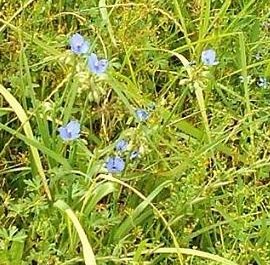Wildflowers: Spiderworts
on Wednesday, August, 10 2011 06:37:43 pm , 1075 words
Categories: Uncategorized , 59731 views

Though I have in years past noticed spiderworts, I have only recently been paying particular attention to these fascinating and beautiful plants. I have never really done much in the way of research on them; however, the wildflowers here in the coastal region of Texas this year* have been truly spectacular, and I have been trying, rather unsuccessfully, to capture their beauty in pictures. Likewise I have been attempting to identify these plant species from a favorite reference book I have on North American flora and fauna. I found the plant illustrated and described therein, and one fact stated about spiderwort blooms so amazed me that I just had to know more!
Despite my study, I'm still not certain if the spiderworts growing locally are specimens of Tradescantia humilis, commonly called "Texas Spiderwort," but the ones I've been seeing here in open prairie areas thriving quite well in full sunlight are all of the same species and are very pretty. While these local plants have bluer blooms than the slightly purplish-pink Texas Spiderworts depicted on internet sites, various references state that bloom color variations of certain spiderworts may be dependent upon soil ph. Texas is home to several species of spiderworts, including the widespread Tradescantia ohiensis, also known as "Bluejacket," which grows over much of the eastern United States. There are six species native to the area around Austin.
Spiderwort is a rather peculiar name for a flowering plant, and explanations for it differ from one reference to another. The genus name (Tradescantia) is in honor of John Tradescan, Senior, head gardener for King Charles I of England. Tradescan was a renowned collector of garden plants and he and his son, John, Jr., who after his father's death in 1638 was also head gardener to King Charles I, were responsible for introducing many species of New World plants to the gardens of Europe. The latter part of the common name of spiderwort (or spider wort) comes from the Anglo-Saxon word "wyrt" meaning "herb" or "root". The "spider"-part of the name is less definitely attributable. One explanation is that it is due to the way in which the blooms (each of which lives but one day) hang like spiders as though on a web. Another attribution states that there was a belief that certain parts of the plant would cure spider bites. (Sap of the plant can be used to soothe scrapes and scratches.) Still another explanation has it that the name comes from the spider-web-like hairs (chains of single cells) that emanate from the stamens of the blossoms of some species.
Yet another explication attributes the name to the web-like streams of mucilaginous substance that effuse from torn and separated stems or leaves. These strands dry very quickly upon exposure to air, creating threads like the strands made by a spider. This characteristic of the plant is also responsible for another common name of the plant, "cow slobber."
While a bouquet of cow slobber may not sound too appealing, consider that cow slobber plants are also edible---Yum, cow slobber!---(stems, leaves, and flowers, can be eaten raw or added, like okra, to stews as a thickening agent). One source states that spiderwort tastes like spinach. Another points out that the blossoms make a colorful garnish for salads. (There is an interesting YouTube video on the preparation of spiderwort: "EatTheWeeds: Episode 15: Spiderwort, Tradescantia.") Sources vary on the degree of edibility of different species of spiderwort, thus, I'd recommend careful research and consultation with local experts before ingesting any wild plant. One website source that gives this caution also states that Tradescantia virginiana is edible, as do many other websites, and yet another states that it is not edible but has medicinal properties.
There are 71 species of the Tradescantia genus. Representatives of this monocotyledonous plant range throughout much of the Americas from southern Canada to northern Argentina. The first species collected for John Tradescan sometime before 1629 (when it was introduced to the gardens of England) was the Tradescantia virginiana. The first fully scientific description of the plant was made in 1898 by John Small a botanist and curator at the New York Botanical Garden.
Spiderworts hybridize easily and partly for this reason have long, since the time of Tradescan, been a garden favorite. Attribution of species in the wild is often compounded due to this tendency to hybridize. Being monocots (plants like grasses whose seeds sprout with one leaf, or cotyledon, as opposed to dicots, which have two cotyledons), spiderworts possess three pedals. (The bloom pattern of monocots is flowers of three, six, or nine petals.) The blooms in the wild are usually blue or a variant thereof. There are six stamens, ending with a yellow or orange tip. As stated, the stamens have fine hairs that are often quite showy. There is a quality about the blooms and stamens of spiderworts that is quite amazing. Spiderworts are more sensative than most of the instruments that exist for the detection of low levels of radiation. The cells of the stamen hairs, which in most varieties are blue, change by mutation from blue to pink when exposed to even the most minute levels to ionizing radiation. Likewise they react in the same way to increased levels of environmental pollution.
Wild spiderworts are often welcomed as garden plants whenever they appear as "volunteers." Wild and domesticated varieties are often used as border plants. They can be grown from seed, from cuttings, and from transplanting of entire plants or their roots. The plants can grow in full sun with little or no shade but need plenty of water for consistent flowering. Each bloom lasts only a day, and if touched in the midday sun, a flower will wither into a sticky blue fluid, especially after the bees or other insects have fertilized it and it has begun to wither. Spiderworts will bloom for several months depending on the varety and locale. In Texas, the flowers can be seen from March to June. (In its home range Tradescantia virginiana blooms from May through August.) The flowers appear in clusters atop the stem and bloom successively over several months. There are many domesticated spectacular varieties of spiderworts and they (as well as their wild cousins) are a beautiful, suitable, and colorful addition to any garden.

Photos:
Spiderwort (possibly Tradescantia humilis, Rose) in Brazoria County, Texas.
John Tradescan, Sr., head gardener to King Charles I of Great Britain.
(*This article was first published 8 April 2011.)
